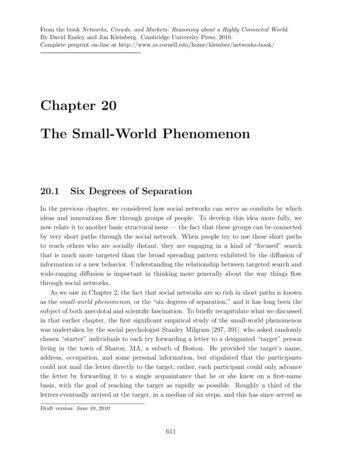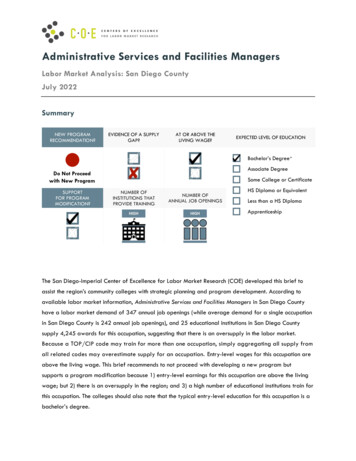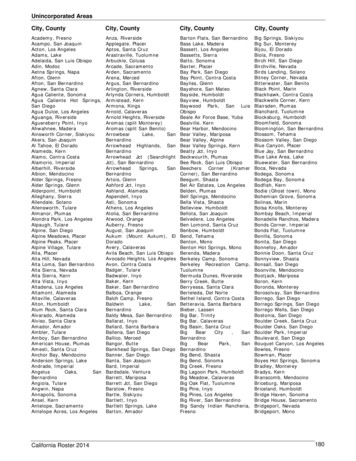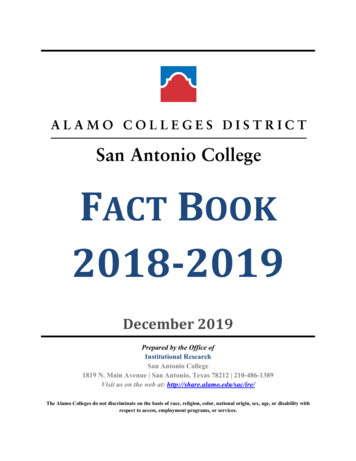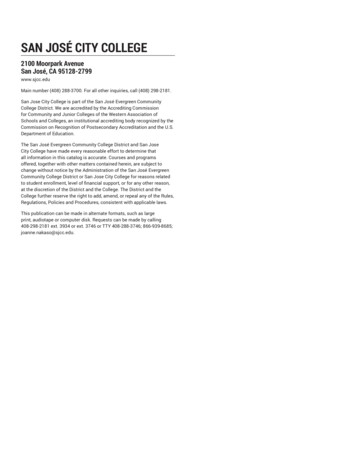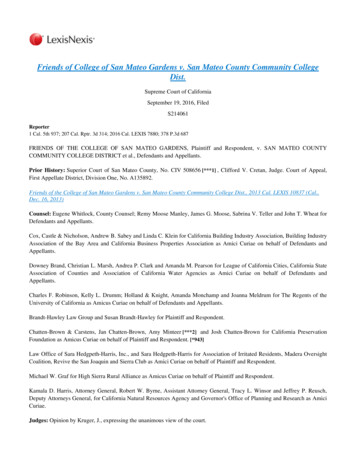
Transcription
Friends of College of San Mateo Gardens v. San Mateo County Community CollegeDist.Supreme Court of CaliforniaSeptember 19, 2016, FiledS214061Reporter1 Cal. 5th 937; 207 Cal. Rptr. 3d 314; 2016 Cal. LEXIS 7880; 378 P.3d 687FRIENDS OF THE COLLEGE OF SAN MATEO GARDENS, Plaintiff and Respondent, v. SAN MATEO COUNTYCOMMUNITY COLLEGE DISTRICT et al., Defendants and Appellants.Prior History: Superior Court of San Mateo County, No. CIV 508656 [***1] , Clifford V. Cretan, Judge. Court of Appeal,First Appellate District, Division One, No. A135892.Friends of the College of San Mateo Gardens v. San Mateo County Community College Dist., 2013 Cal. LEXIS 10837 (Cal.,Dec. 16, 2013)Counsel: Eugene Whitlock, County Counsel; Remy Moose Manley, James G. Moose, Sabrina V. Teller and John T. Wheat forDefendants and Appellants.Cox, Castle & Nicholson, Andrew B. Sabey and Linda C. Klein for California Building Industry Association, Building IndustryAssociation of the Bay Area and California Business Properties Association as Amici Curiae on behalf of Defendants andAppellants.Downey Brand, Christian L. Marsh, Andrea P. Clark and Amanda M. Pearson for League of California Cities, California StateAssociation of Counties and Association of California Water Agencies as Amici Curiae on behalf of Defendants andAppellants.Charles F. Robinson, Kelly L. Drumm; Holland & Knight, Amanda Monchamp and Joanna Meldrum for The Regents of theUniversity of California as Amicus Curiae on behalf of Defendants and Appellants.Brandt-Hawley Law Group and Susan Brandt-Hawley for Plaintiff and Respondent.Chatten-Brown & Carstens, Jan Chatten-Brown, Amy Minteer [***2] and Josh Chatten-Brown for California PreservationFoundation as Amicus Curiae on behalf of Plaintiff and Respondent. [*943]Law Office of Sara Hedgpeth-Harris, Inc., and Sara Hedgpeth-Harris for Association of Irritated Residents, Madera OversightCoalition, Revive the San Joaquin and Sierra Club as Amici Curiae on behalf of Plaintiff and Respondent.Michael W. Graf for High Sierra Rural Alliance as Amicus Curiae on behalf of Plaintiff and Respondent.Kamala D. Harris, Attorney General, Robert W. Byrne, Assistant Attorney General, Tracy L. Winsor and Jeffrey P. Reusch,Deputy Attorneys General, for California Natural Resources Agency and Governor's Office of Planning and Research as AmiciCuriae.Judges: Opinion by Kruger, J., expressing the unanimous view of the court.
Page 2 of 121 Cal. 5th 937, *943; 207 Cal. Rptr. 3d 314, **314; 2016 Cal. LEXIS 7880, ***2Opinion by: KrugerOpinion[**317] KRUGER, J.—To ensure that governmental agencies and the public are adequately informed about theenvironmental impact of public decisions, the California Environmental Quality Act (CEQA) (Pub. Resources Code, § 21000et seq.) requires a lead agency (id., § 21067) to prepare an environmental impact report (EIR) before approving a new projectthat “may have a significant effect on the environment” (id., § 21151, subd. (a)). When changes are proposed to a project forwhich an EIR has already been prepared, the agency must prepare a subsequent or [***3] supplemental EIR only if the changesare “[s]ubstantial” and require “major revisions” of the previous EIR. (Id., § 21166.) Guidelines promulgated by the stateNatural Resources Agency (Resources Agency) (Cal. Code Regs., tit. 14, § 15000 et seq.; hereafter CEQA Guidelines) extendthis subsequent review framework to projects for which a negative declaration was initially [**318] adopted, and no EIRprepared, because the agency had concluded the project would have no potentially significant environmental effects. (CEQAGuidelines, § 15162.)In this case, a community college district proposed a district-wide facilities improvement plan that called for demolishingcertain buildings and renovating others. The district approved the plan after determining that it would have no potentiallysignificant, unmitigated effect on the environment. Years later, the district proposed changes to the plan. The changes includeda proposal to demolish one building complex that had originally been slated for renovation, and to renovate two other buildingsthat had originally been slated for demolition. The district approved the changes after concluding they did not require thepreparation of a subsequent or supplemental EIR under Public Resources Code section 21166 (section 21166) and CEQAGuidelines section 15162. The Court of Appeal invalidated the district's decision, finding [***4] it “clear” as a matter of lawthat the district's proposed demolition of the [*944] building complex was not merely a change to its previously approvedproject, but a new project altogether. The court ruled that the district's proposal was therefore subject to the initialenvironmental review standards of Public Resources Code section 21151 (section 21151) rather than the subsequent reviewstandards of section 21166 and CEQA Guidelines section 15162.We conclude that the Court of Appeal erred in its application of this new project test. When an agency proposes changes to apreviously approved project, CEQA does not authorize courts to invalidate the agency's action based solely on their ownabstract evaluation of whether the agency's proposal is a new project, rather than a modified version of an old one. Under thestatutory scheme, the agency's environmental review obligations depend on the effect of the proposed changes on thedecisionmaking process, rather than on any abstract characterization of the project as “new” or “old.” An agency that proposesproject changes thus must determine whether the previous environmental document retains any relevance in light of theproposed changes and, if so, whether major revisions to the previous environmental document are nevertheless required [***5]due to the involvement of new, previously unstudied significant environmental impacts. These are determinations for theagency to make in the first instance, subject to judicial review for substantial evidence.I.A.“In CEQA, the Legislature sought to protect the environment by the establishment of administrative procedures drafted to‘[e]nsure that the long-term protection of the environment shall be the guiding criterion in public decisions.’” (No Oil, Inc. v.City of Los Angeles (1974) 13 Cal.3d 68, 74 [118 Cal. Rptr. 34, 529 P.2d 66] (No Oil).) At the “heart of CEQA” (CEQAGuidelines, § 15003, subd. (a)) is the requirement that public agencies prepare an EIR for any “project” that “may have asignificant effect on the environment.” (§ 21151, subd. (a); see id., §§ 21080, subd. (a), 21100, subd. (a).) The purpose of theEIR is “to provide public agencies and the public in general with detailed information about the effect which a proposed projectis likely to have on the environment; to list ways in which the significant effects of such a project might be minimized; and toindicate alternatives to such a project.” (Pub. Resources Code, § 21061.) The EIR thus works to “inform the public and itsresponsible officials of the environmental [**319] consequences of their decisions before they are made,” thereby protecting“‘not only the environment but also informed self-government.’” (Citizens of Goleta Valley v. Board of Supervisors (1990) 52Cal.3d 553, 564 [276 Cal. Rptr. 410, 801 P.2d 1161], quoting Laurel Heights Improvement Assn. v. [*945] Regents ofUniversity of California (1988) 47 Cal.3d 376, 392 [253 Cal.Rptr. 426, 764 P.2d 278] ( [***6] Laurel Heights).)
Page 3 of 121 Cal. 5th 937, *945; 207 Cal. Rptr. 3d 314, **319; 2016 Cal. LEXIS 7880, ***6(1) Under CEQA and its implementing guidelines, an agency generally conducts an initial study to determine “if the projectmay have a significant effect on the environment.” (CEQA Guidelines, § 15063, subd. (a).) If there is substantial evidence thatthe project may have a significant effect on the environment, then the agency must prepare and certify an EIR before approvingthe project. (No Oil, supra, 13 Cal.3d at p. 85; see also Pub. Resources Code, §§ 21100 [state agencies], 21151 [localagencies].) On the other hand, no EIR is required if the initial study reveals that “there is no substantial evidence that theproject or any of its aspects may cause a significant effect on the environment.” (CEQA Guidelines, § 15063, subd. (b)(2).) Theagency instead prepares a negative declaration “briefly describing the reasons that a proposed project will not have asignificant effect on the environment and therefore does not require the preparation of an EIR.” (Id., § 15371; see id., § 15070.)Even when an initial study shows a project may have significant environmental effects, an EIR is not always required. Thepublic agency may instead prepare a mitigated negative declaration (MND) if “(1) revisions in the project plans before theproposed negative declaration and initial study are released [***7] for public review would avoid the effects or mitigate theeffects to a point where clearly no significant effect on the environment would occur, and (2) there is no substantial evidence inlight of the whole record before the public agency that the project, as revised, may have a significant effect on theenvironment.” (Pub. Resources Code, § 21064.5.)(2) For many projects, this is the end of the environmental review process. But like all things in life, project plans are subject tochange. When such changes occur, section 21166 provides that “no subsequent or supplemental environmental impact reportshall be required” unless at least one or more of the following occurs: (1) “[s]ubstantial changes are proposed in the projectwhich will require major revisions of the environmental impact report,” (2) there are “[s]ubstantial changes” to the project'scircumstances that will require major revisions to the EIR, or (3) new information becomes available. (§ 21166.)(3) Although section 21166 does not, by its terms, address cases in which a negative declaration or an MND, rather than anEIR, has been prepared, CEQA Guidelines section 15162 provides that no subsequent EIR is required either “[w]hen an EIRhas [previously] been certified or [when] a negative declaration [has previously been] adopted for a project,” unless [***8]there are substantial changes to a project or its circumstances that will require major revisions to the existing EIR or negativedeclaration. (CEQA Guidelines, [*946] § 15162, subd. (a), italics added; see also § 21166.) “If changes to a project or itscircumstances occur or new information becomes available after adoption of a negative declaration,” and if no subsequent EIRis required, the agency “shall determine whether to prepare a subsequent negative declaration, an addendum, or no furtherdocumentation.” (CEQA Guidelines, § 15162, subd. (b).) CEQA Guidelines further provide that an agency must prepare anaddendum to a previously certified EIR “if some changes or additions [**320] are necessary but none of the conditionsdescribed in Section 15162 calling for preparation of a subsequent EIR have occurred.” (Id., § 15164, subd. (a).) An addendumto an adopted negative declaration “may be prepared if only minor technical changes or additions are necessary or none of theconditions described in Section 15162 calling for the preparation of a subsequent EIR or negative declaration have occurred.”(Id., § 15164, subd. (b).)B.This case arises from a series of proposed facilities improvements to a college campus in San Mateo County. In 2006, the SanMateo Community College District and its board of trustees (collectively, [***9] District) adopted a facilities master plan(Plan) proposing nearly 1 billion in new construction and facilities renovations at the District's three college campuses. At theCollege of San Mateo (College), the District's Plan included a proposal to demolish certain buildings and renovate others. Thebuildings slated for renovation included the College's “Building 20 complex,” which includes a small cast-in-place concreteclassroom and lab structure, greenhouse, lath house, surrounding garden space, and an interior courtyard.In 2006, the District published an initial study and mitigated negative declaration analyzing the physical environmental effectsof implementing the Plan's proposed improvements at the College, including the proposed rehabilitation of the Building 20complex. The MND stated that, with the implementation of certain mitigation measures, the Plan would not have a significanteffect on the environment. In 2007, the District certified its initial study and adopted the 2006 MND.When the District later failed to obtain funding for the planned Building 20 complex renovations, it re-evaluated the proposedrenovation. In May 2011, the District issued a notice of determination, [***10] indicating that it would instead demolish, ratherthan renovate, the “complex and replace it with parking lot, accessibility, and landscaping improvements.” The District alsoproposed to renovate two other buildings, buildings 15 and 17, that had previously been slated for demolition.
Page 4 of 121 Cal. 5th 937, *946; 207 Cal. Rptr. 3d 314, **320; 2016 Cal. LEXIS 7880, ***10The District concluded a subsequent or supplemental EIR was not required. It instead addressed the change through anaddendum to its 2006 initial study [*947] and MND, concluding that “the project changes would not result in a new orsubstantially more severe impact than disclosed in the 2006 [initial study and mitigated negative declaration]. Therefore, anaddendum is the appropriate CEQA documentation.” (San Mateo County Community College Dist., CEQA Addendum:Evaluation of Project Change to Building 20 Complex (May 2011) p. 20.)The newly proposed demolition of the Building 20 complex, and particularly the demolition of the complex's associatedgardens, proved controversial. Certain members of the public, as well as a number of College students and faculty, vocallycriticized the demolition proposal at public hearings. The District nevertheless approved demolition of the Building 20 complexin accordance [***11] with the addendum.Plaintiff Friends of the College of San Mateo Gardens filed suit challenging the approval. The District thereafter rescinded itsoriginal addendum and issued a revised addendum in August 2011. The revised addendum reiterated the original addendum'sconclusion but bolstered its analysis. On August 24, 2011, after public comment and discussion, the revised addendum wasadopted and demolition of the Building 20 complex was reapproved. Plaintiff voluntarily dismissed its prior suit and filed the[**321] present action, challenging the revised addendum and the reapproval of the demolition. Plaintiff sought a peremptorywrit of mandate ordering the District to set aside its approval of the Building 20 complex demolition and to fully comply withCEQA, including preparing an adequate EIR and adopting feasible alternatives and mitigation measures. The trial court foundthat the demolition project was inconsistent with the previously approved plan and that its impacts were not addressed in the2006 mitigated negative declaration. The trial court thus granted plaintiff's petition for a writ of mandate, ordering the Districtto refrain from taking further action adversely affecting the [***12] physical environment at the Building 20 complex pendingthe District's full compliance with CEQA.The Court of Appeal affirmed. Relying primarily on Save Our Neighborhood v. Lishman (2006) 140 Cal.App.4th 1288 [45 Cal.Rptr. 3d 306] (Save Our Neighborhood), the court concluded, as a threshold matter of law, that the proposed buildingdemolition was a new project, rather than a project modification. The court accordingly concluded that the agency is required toengage in an initial study of the project to determine whether an EIR is required under section 21151.In so holding, the Court of Appeal deepened a disagreement among the appellate courts concerning the reasoning of Save OurNeighborhood, supra, 140 Cal.App.4th 1288. In Save Our Neighborhood, the Court of Appeal [*948] invalidated an agency'sapproval of a proposed modification to a project that had previously been approved via negative declaration. Although theoriginal project and the proposed modification involved “the same land and similar mixes of uses,” there were a number ofdifferences. (Id. at p. 1300 [the original project was a 106-unit motel that included some 15,000 square feet of other retail uses;the purported modification was a 102-unit hotel that did not include any separate retail uses and was sponsored by a differentdeveloper than the original project].) The court [***13] held that the agency had erroneously relied on the statutory andregulatory provisions governing the preparation of subsequent or supplemental EIRs because the proposal was not amodification at all but rather a “new project altogether.” (Id. at p. 1301.) The court concluded that whether the proposalconstituted a “new project” was “a threshold question” of law and rejected the agency's determination to treat the proposal as amodification after reviewing that question de novo. (Ibid.)Save Our Neighborhood was criticized in Mani Brothers Real Estate Group v. City of Los Angeles (2007) 153 Cal.App.4th1385, 1400 [64 Cal. Rptr. 3d 79] (Mani Brothers). In Mani Brothers, the agency certified an EIR for an original projectconsisting of “five buildings with offices, a 550- to 770-room hotel, retail facilities, and an optional cultural center.” (Id. atp. 1389.) Fifteen years later, the project's developer proposed to revise the project, including by “reduc[ing] much of the[o]riginal [p]roject's office and retail space, and eliminat[ing] the optional cultural use component, while maintaining the hotelcomponent and adding residential components,” which increased the overall size of the project from “approximately 2.7million square feet to a maximum of just over 3.2 million square feet.” (Id. at p. 1391.) The Mani Brothers court affirmed theagency's determination that [***14] the proposal was a modification of an existing project and found the agency's conclusionthat no supplemental EIR was required to be supported by substantial evidence. (Id. at pp. 1398–1399.) The court distinguishedSave Our Neighborhood, supra, 140 Cal.App.4th 1288, [**322] on the ground that it “involved an addendum to a previouslycertified negative declaration and not an addendum to a previously certified EIR.” (Mani Brothers, at p. 1400.) But the courtalso opined that, even if it were not distinguishable, Save Our Neighborhood's “fundamental analysis is flawed.” (ManiBrothers, at p. 1400.) The court explained that Save Our Neighborhood's threshold “‘new project’ test inappropriately
Page 5 of 121 Cal. 5th 937, *948; 207 Cal. Rptr. 3d 314, **322; 2016 Cal. LEXIS 7880, ***14bypassed otherwise applicable statutory and regulatory provisions,” and “undermine[d] the deference due the agency.” (ManiBrothers, at pp. 1400–1401; see also Pub. Resources Code, § 21083.1.)The Court of Appeal in this case acknowledged the disagreement between Save Our Neighborhood and Mani Brothers. Itconcluded, however, that “in the narrow circumstances of the present case, where it is clear from the [*949] record that thenature of the project has fundamentally and qualitatively changed to the point where the new proposal is actually a new projectaltogether,” the approach adopted in Save Our Neighborhood “is both workable and sound.” 1 Here, the [***15] courtobserved, the District's 2011 addendum “changes ‘renovation’ of the Building 20 complex to ‘demolition’ of the complex'sbuildings and a substantial portion of the gardens.” The court concluded, “[A]t least under the straightforward facts of thepresent case we can decide, as a matter of law, that the demolition project is a ‘new project.’”The Court of Appeal acknowledged the District's argument that the proposal to demolish the Building 20 complex is only onecomponent of the District's project, which, as revised, now proposes to renovate two buildings that had previously been slatedfor demolition. [***16] Relying on Sierra Club v. County of Sonoma (1992) 6 Cal.App.4th 1307 [8 Cal. Rptr. 2d 473] (SierraClub), however, the Court of Appeal concluded that when an agency initially adopts a broad, large-scale environmentaldocument—such as the 2006 MND here—that addresses the “environmental effects of a complex long-term management plan”(id. at p. 1316), a court can find a material alteration regarding a particular site or activity covered by that plan to be a newproject triggering environmental review under section 21151.II.(4) Once a project has been subject to environmental review and received approval, section 21166 and CEQA Guidelinessection 15162 limit the circumstances under which a subsequent or supplemental EIR must be prepared. These limitations aredesigned to balance CEQA's central purpose of promoting consideration of the environmental consequences of public decisionswith interests in finality and efficiency. (See Bowman v. City of Petaluma (1986) 185 Cal.App.3d 1065, 1074 [230 Cal. Rptr.413] (Bowman).) Thus, as both Save Our Neighborhood and Mani Brothers explained, “The purpose behind the requirement ofa subsequent or supplemental [**323] EIR or negative declaration is to explore environmental impacts not considered in theoriginal environmental document. The event of a change in a project is not an occasion to revisit environmental concernslaid to rest in the original analysis. Only changed [***17] circumstances are at issue.” (Save Our [*950] Neighborhood,supra, 140 Cal.App.4th at p. 1296; accord, Mani Brothers, supra, 153 Cal.App.4th at pp. 1398–1399.)Consistent with these principles, section 21166 and CEQA Guidelines section 15162 provide that an agency that proposeschanges to a previously approved project must determine whether the changes are “[s]ubstantial” and “will require majorrevisions of the previous EIR or negative declaration due to the involvement of new significant environmental effects or asubstantial increase in the severity of previously identified significant effects.” (CEQA Guidelines, § 15162, subd. (a)(1).) If theproposed changes meet that standard, then a subsequent or supplemental EIR is required.Drawing on the reasoning of Save Our Neighborhood, plaintiff argues that implicit in the statutory and regulatory scheme is athreshold inquiry that determines whether the subsequent review provisions properly apply in the first place. Because section21166 and CEQA Guidelines section 15162 both refer to substantial changes to “a project”—and not, as the Save OurNeighborhood court observed, changes to “a new project proposed for a site where a similar project was previouslyapproved”—a court reviewing an agency's proposed approval of project changes must first satisfy itself that the project remainsthe same project as before, rather than an entirely new project, before proceeding [***18] to evaluate whether the changes callfor a subsequent or supplemental EIR under CEQA's subsequent review provisions. (Save Our Neighborhood, supra, 140Cal.App.4th at p. 1297.) Plaintiff further argues that whether an agency's proposal qualifies as a new project is a question of1 Shortlyafter issuing its decision in this case, the same division of the Court of Appeal issued a decision in which it declined to apply theSave Our Neighborhood new project test to review a city's determination that changes to a previously approved project did not require asupplemental or subsequent EIR. (Latinos Unidos de Napa v. City of Napa (2013) 221 Cal.App.4th 192, 201–202 [164 Cal. Rptr. 3d 274].)Explaining that “‘a court should tread with extraordinary care before reversing a local agency's determination about the environmental impactof changes to a project,’” the court instead “elect[ed] to evaluate the City's decision to proceed under section 21166 using the substantialevidence test.” (Id. at p. 202.)
Page 6 of 121 Cal. 5th 937, *950; 207 Cal. Rptr. 3d 314, **323; 2016 Cal. LEXIS 7880, ***18law for courts to decide based on their independent judgment. The premise of plaintiff's argument is sound, but its conclusionsare not.Plaintiff is correct that the subsequent review provisions can apply only if the project has been subject to initial review; theycan have no application if the agency has proposed a new project that has not previously been subject to review. But plaintiff'sapproach would assign to courts the authority—indeed, the obligation—to determine whether an agency's proposal qualifies asa new project, in the absence of any standards to govern the inquiry. Plaintiff does not suggest any standards, nor do the caseson which it relies. The Save Our Neighborhood court simply asserted that the modified project proposal at issue was a newproject, pointing out that while the “projects” at issue involved the “same land” and a “similar mix[] of uses,” they “ha[d]different proponents and there [was] no suggestion the latter project utilized any of [***19] the drawings or other materialsconnected with the earlier project ” (Save Our Neighborhood, supra, 140 Cal.App.4th at p. 1300). The court neitherpurported to give any content to the determination whether a proposal counts as a new project, nor did it explain why thedistinctions it identified make any difference for purposes of CEQA, whose aim is simply to “compel government to makedecisions with environmental consequences in mind.” [*951] (Bozung v. Local Agency Formation Com. (1975) 13 Cal.3d 263,283 [118 Cal. Rptr. 249, 529 P.2d 1017].) The Court of Appeal in this case likewise offered no standards to guide the inquiry,simply declaring it [**324] “clear” that the proposal at issue constituted a “new project.”In the absence of any benchmark for measuring the newness of a given project, the new project test plaintiff urges wouldinevitably invite arbitrary results. As the Court of Appeal in Mani Brothers observed, to ask whether an agency proposalconstitutes a “‘new project’” in the abstract “does not provide an objective or useful framework. Drastic changes to a projectmight be viewed by some as transforming the project to a new project, while others may characterize the same drastic changesin a project as resulting in a dramatically modified project. Such labeling entails no specific guidelines and simply is not helpfulto our analysis.” [***20] (Mani Brothers, supra, 153 Cal.App.4th at p. 1400.)(5) What is more, to ask whether proposed agency action constitutes a new project, purely in the abstract, misses the reasonwhy the characterization matters in the first place. The central purpose of CEQA is to ensure that agencies and the public areadequately informed of the environmental effects of proposed agency action. The subsequent review provisions, as Save OurNeighborhood recognized, are accordingly designed to ensure that an agency that proposes changes to a previously approvedproject “explore[s] environmental impacts not considered in the original environmental document.” (Save Our Neighborhood,supra, 140 Cal.App.4th at p. 1296.) This assumes that at least some of the environmental impacts of the modified project wereconsidered in the original environmental document, such that the original document retains some relevance to the ongoingdecisionmaking process. A decision to proceed under CEQA's subsequent review provisions must thus necessarily rest on adetermination—whether implicit or explicit—that the original environmental document retains some informational value. If theproposed changes render the previous environmental document wholly irrelevant to the decisionmaking process, then it is onlylogical that the agency start [***21] from the beginning under section 21151 by conducting an initial study to determinewhether the project may have substantial effects on the environment.(6) It follows that, for purposes of determining whether an agency may proceed under CEQA's subsequent review provisions,the question is not whether an agency's proposed changes render a project new in an abstract sense. Nor does the inquiry turnon the identity of the project proponent, the provenance of the drawings, or other matters unrelated to the environmentalconsequences associated with the project. (Cf. Save Our Neighborhood, supra, 140 Cal.App.4th at p. 1300.) Rather, underCEQA, when there is a change in plans, circumstances, or available information after a project has received [*952] initialapproval, the agency's environmental review obligations “turn[] on the value of the new information to the still pendingdecisionmaking process.” (Marsh v. Oregon Natural Resources Council (1989) 490 U.S. 360, 374 [104 L. Ed. 2d 377, 109 S.Ct. 1851] (Marsh).) 2 [**325] If the original environmental document retains some informational value despite the proposedchanges, then the agency proceeds to decide under CEQA's subsequent review provisions whether project changes will require2 Inthis respect, CEQA resembles the federal statute on which it was modeled. (See Marsh, supra, 490 U.S. at p. 374 [agencies employ a“‘rule of reason’” in determining whether to issue a supplemental environmental impact statement under the National Environmental PolicyAct of 1969, 42 U.S.C. § 4321 et seq.]; Citizens of Goleta Valley v. Board of Supervisors, supra, 52 Cal.3d 553, 565, fn. 4 [“CEQA wasmodeled on the National Environmental Policy Act (NEPA)” and “‘we have consistently treated judicial and administrative interpretation ofthe latter enactment as persuasive authority in interpreting CEQA.’”].)
Page 7 of 121 Cal. 5th 937, *952; 207 Cal. Rptr. 3d 314, **325; 2016 Cal. LEXIS 7880, ***21major revisions to the original environmental document because of the involvement of new, previously unconsideredsignificant environmental effects. [***22] 3(7) This understanding of the relevant statutory framework [***23] supplies the benchmark missing from the Court of Appeal'sapplication of the new project test in this case. It also exposes the
Friends of College of San Mateo Gardens v. San Mateo County Community College Dist. Supreme Court of California September 19, 2016, Filed S214061 Reporter 1FRIENDS Cal. 5th 937; OF 207 THE Cal. Rptr.COLLEGE 3d 314; 2016OF Cal.SAN LEXIS MATEO 7880; GARDENS,378 P.3d 687 Plaintiff and Respondent, v. SAN MATEO COUNTY COMMUNITY COLLEGE DISTRICT et .

